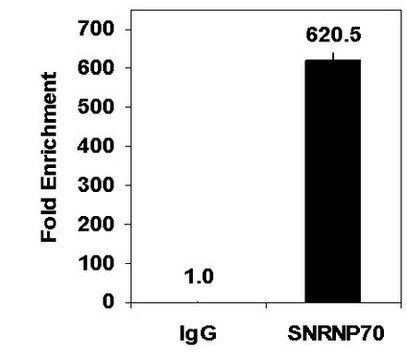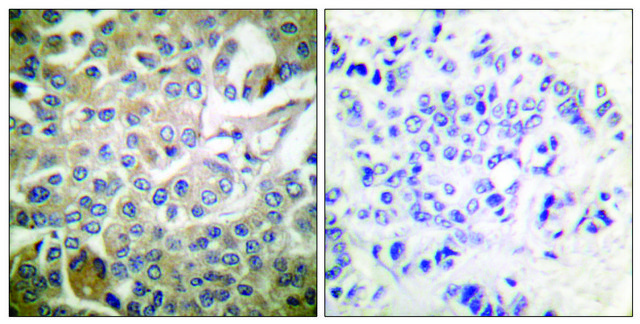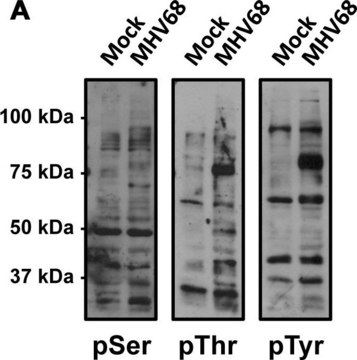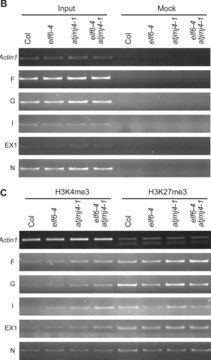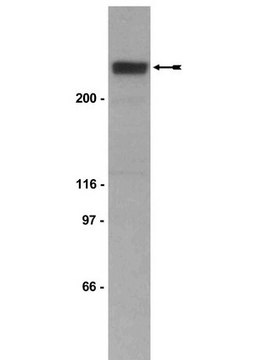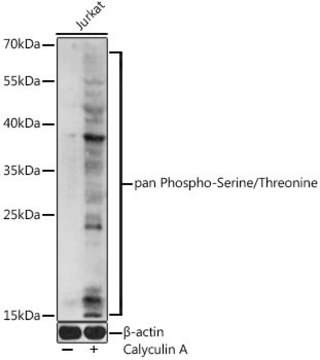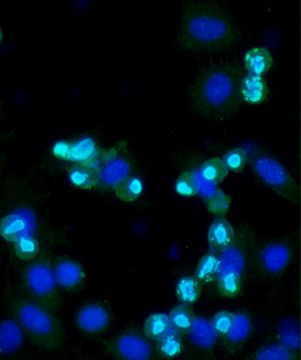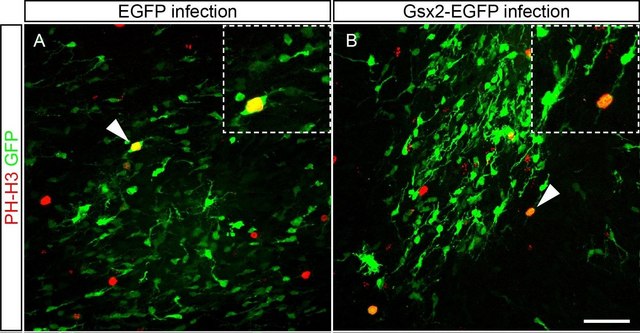MABS27
Anti-Diglycyl Lysine (Clone GX41) Antibody
clone GX41, from mouse
Sign Into View Organizational & Contract Pricing
All Photos(1)
Synonym(s):
Diglycyl Lysine
UNSPSC Code:
12352203
eCl@ss:
32160702
NACRES:
NA.41
Recommended Products
biological source
mouse
Quality Level
antibody form
purified immunoglobulin
antibody product type
primary antibodies
clone
GX41, monoclonal
species reactivity
human, mouse, rat
species reactivity (predicted by homology)
all
technique(s)
immunoprecipitation (IP): suitable
western blot: suitable
isotype
IgG1κ
shipped in
wet ice
target post-translational modification
unmodified
General description
Anti-Diglycyl Lysine has been shown to specifically detect peptides derived from the ubiquitinated portion of proteins. Diglycyl Lysine, clone GX41 is thought to find diglycyl-lysine moieties that are created and left behind at places of ubiquitination after digestion with trypsin has occurred.
Specificity
Antibody recognizes lysine residues modified by diglycine, a residue left at sites of ubiquitination after trypsin digestions.
Broad species cross-reactivity expected based on 100% sequence homology.
Immunogen
Linear peptide corresponding to Diglycyl Lysine.
Application
Anti-Diglycyl Lysine (Clone GX41) Antibody detects level of Diglycyl Lysine (Clone GX41) & has been published & validated for use in WB & IP.
Immunoprecipitation Analysis: 10 µg of Anti-Diglycyl Lysine immunoprecipitated peptides containing Diglycyl Lysine modification from isolated ubiquitinated proteins which were obtained from a human cell line.
Mass Spectrometry Analysis: A previous lot was used by an independent a laboratory in Mass Spec. Image courtesy of Samie Jaffrey, Cornell Medical College.
Mass Spectrometry Analysis: A previous lot was used by an independent a laboratory in Mass Spec. Image courtesy of Samie Jaffrey, Cornell Medical College.
Research Category
Signaling
Signaling
Research Sub Category
General Post-translation Modification
General Post-translation Modification
Quality
Evaluated by Western Blot in BSA protein and Diglycine modified BSA.
Western Blot Analysis: 0.5 µg/mL of this antibody detected Diglycyl Lysine on 10 µg of BSA protein and Diglycine modified BSA.
Western Blot Analysis: 0.5 µg/mL of this antibody detected Diglycyl Lysine on 10 µg of BSA protein and Diglycine modified BSA.
Target description
Molecular weight can vary depending on the size of the protein or peptides containing Diglycyl modified lysine residues.
Physical form
Format: Purified
Protein G
Purified mouse monoclonal IgG1κ in buffer containing 0.1 M Tris-Glycine (pH 7.4), 150 mM NaCl with 0.05% sodium azide.
Storage and Stability
Stable for 1 year at 2-8°C from date of receipt.
Analysis Note
Control
BSA protein and Diglycine modified BSA
BSA protein and Diglycine modified BSA
Other Notes
Concentration: Please refer to the Certificate of Analysis for the lot-specific concentration.
Disclaimer
Unless otherwise stated in our catalog or other company documentation accompanying the product(s), our products are intended for research use only and are not to be used for any other purpose, which includes but is not limited to, unauthorized commercial uses, in vitro diagnostic uses, ex vivo or in vivo therapeutic uses or any type of consumption or application to humans or animals.
WGK
WGK 1
Flash Point(F)
Not applicable
Flash Point(C)
Not applicable
Certificates of Analysis (COA)
Search for Certificates of Analysis (COA) by entering the products Lot/Batch Number. Lot and Batch Numbers can be found on a product’s label following the words ‘Lot’ or ‘Batch’.
Already Own This Product?
Find documentation for the products that you have recently purchased in the Document Library.
Meghan C Burke et al.
Journal of proteome research, 13(12), 5965-5972 (2014-10-07)
We provide evidence at the molecular level that ubiquitinated proteins are present in exosomes shed by myeloid-derived suppressor cells (MDSC). Ubiquitin was selected as a post-translational modification of interest because it is known to play a determinant role in the
Niladri K Sinha et al.
eLife, 9 (2020-08-04)
Translation of aberrant mRNAs induces ribosomal collisions, thereby triggering pathways for mRNA and nascent peptide degradation and ribosomal rescue. Here we use sucrose gradient fractionation combined with quantitative proteomics to systematically identify proteins associated with collided ribosomes. This approach identified
Our team of scientists has experience in all areas of research including Life Science, Material Science, Chemical Synthesis, Chromatography, Analytical and many others.
Contact Technical Service